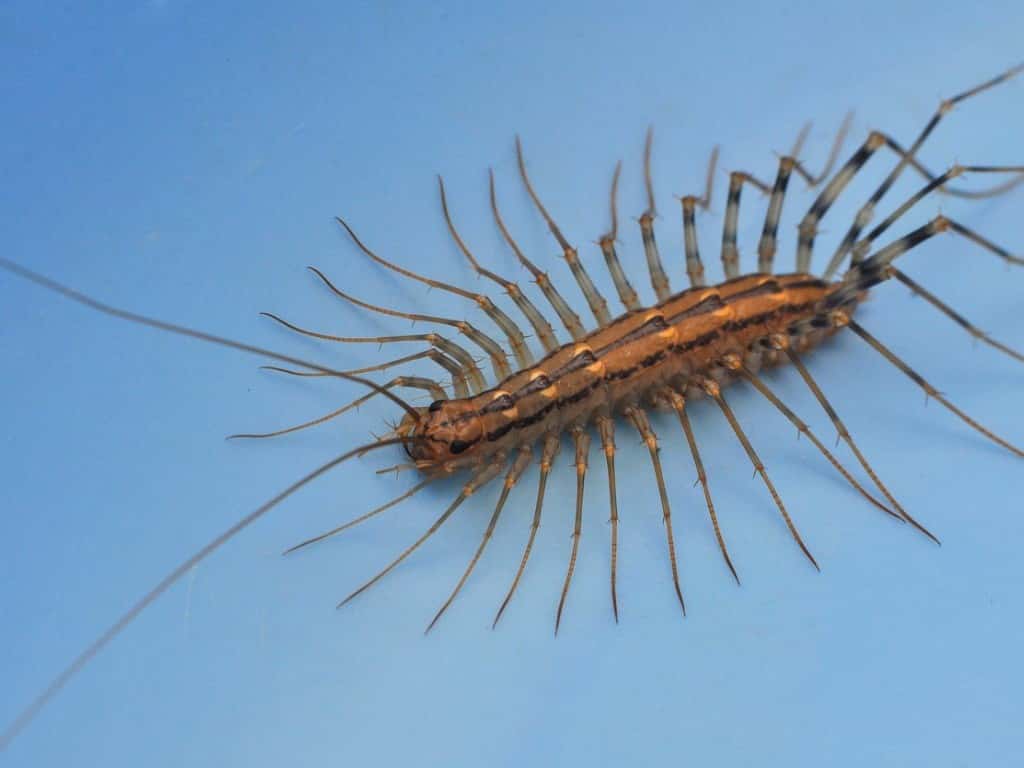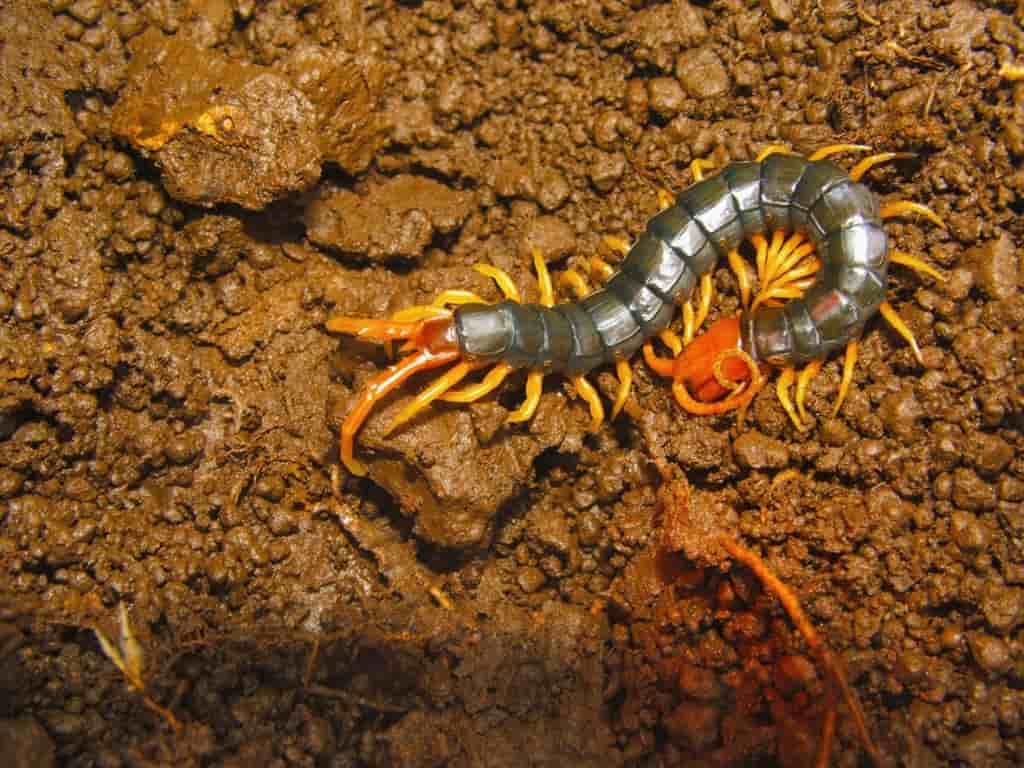Centipede Stings
How Harmful Are They?

The Bottom Line
Centipedes can inflict painful stings, but most are small and rarely sting humans. They live in damp places and hunt for prey at night. Centipedes are considered beneficial because they help control household pests such as cockroaches, silverfish, and ants.

The Full Story
Does the mention of centipedes cause the hairs on the back of your neck to stand up? What could possibly be good about these snakelike creatures that scurry around on waves of tiny legs? Anything so creepy must be poisonous, right? Fortunately, the answer to this question is "no." Although all centipedes can inflict painful stings, they usually do not sting people. (Centipedes do not "bite" because instead of jaws, they use a pair of specially modified hollow front legs to pinch prey and deliver venom.) Their prey include household pests such as cockroaches, spiders, silverfish, and ants. Centipedes are generally beneficial and mild-mannered creatures that don't deserve their scary reputation. The fear of centipedes probably causes much more suffering than centipedes themselves.
Centipedes are not insects and are more closely related to lobsters, crayfish, and shrimp. They are descended from prehistoric centipedes that could be up to one meter (39 inches) long. Although "centipede" means "100 feet," the number can range from 30 to more than 350. The flattened, wormlike body has one pair of legs per body segment. Depending on the species, they can range in length from less than an inch to a foot or more. They are found in nearly every climate on earth, from tropical rainforests to deserts to the arctic. Because their bodies do not retain water very well, centipedes need to hide in dark, moist places like under stones and boards, in crawlspaces and basements, and in rotten logs. Centipedes come out at night when their prey are most active. No matter where you live, watch out for centipedes in damp, cool areas, and turn on the lights if you get up at night.
The centipede's sinister reputation can be attributed to a single group, the genus Scolopendra. Centipedes in this group run large, ranging from four inches to over a foot in length. They have names such as giant desert centipede, Vietnamese centipede, Amazonian giant centipede, and Texas redheaded centipede. These centipedes can be aggressive and are much more likely to deliver a painful sting than the common, smaller varieties of centipedes. The venom of Scolopendra centipedes causes burning pain that can spread up the limb from a toe or finger, and persist for several days or even longer. These super-centipedes live mainly in the tropics and warmer climate zones. It's reassuring to remember that the vast majority of centipedes belong to a different group called "house centipedes" (genus Scutigera), which are less than three inches in length and are relatively harmless.
If you encounter a centipede, it will most likely try to run away. However, when the escape route involves part of you, its tiny sharp legs might leave a trail of small pinpricks in the skin. (Contrary to legend, only the first pair of a centipede's legs contain venom.) In the unusual case of a centipede stinging a human, the resulting symptoms resemble a bee sting with pain, redness, and swelling. Wash the exposed skin with soap and water, and take an over-the-counter analgesic such as acetaminophen or ibuprofen for pain. Centipede venoms are heat-labile, and warm-water immersion may help reduce pain and swelling. Interestingly, ice packs have also been shown to reduce the pain associated with centipede envenomation. Because a centipede sting leaves a puncture wound, make sure that you've had a tetanus shot in the last 10 years. If the area becomes infected (expanding swelling and redness, fever, or pus), medical attention might be necessary. If allergic symptoms (hives, dizziness, mouth or throat swelling, or trouble breathing) occur, use an EpiPen or similar device if you have one and seek medical attention. Fortunately, most centipede stings result in localized symptoms only. Death has rarely been reported to occur after centipede envenomation in tropical locations outside of the United States.
Until recently, we thought we knew everything there was to know about centipedes. Then in 2016 scientists announced that a new type of centipede had been discovered, able to live both on land and in fresh water. This new amphibious species belongs to the genus Scolopendra and, like others in that group, is very large (up to eight inches) and able to inflict a painful sting. It lives in Southeast Asia and is known to walk underwater and swim like an eel. Like other centipedes, it comes out at night to hunt for food.
The next time you see a centipede and are tempted to reach for the bug spray, try to look past their frightening appearance and remember that not only are centipedes beneficial in helping control insect pests, they're usually less dangerous than the bug spray! You can call Poison Control at 1-800-222-1222 or use the webPOISONCONTROL® online tool at any time for expert guidance if you are stung.
Leslie A. McCament-Mann, PhD, RPh
Clinical Toxicologist
Poisoned?
Call 1-800-222-1222 or
Prevention Tips
- Be aware that centipedes are found almost anywhere in the world and that they prefer dark, damp hiding places. Turn on the lights before you approach such spaces and protect your hands and feet in particular.
- Make your home less attractive to centipedes. Improve ventilation and clear out clutter in damp basements. Fill cracks and crevices in block walls and concrete floors. Remove fallen leaves and vegetation outside and move the woodpile away from the house. Ensure that doors and windows are tight-fitting and use weather stripping.
- Realize that there is a possibility you might have an allergic reaction if a centipede stings you. Be prepared to use an EpiPen or similar device if you have one, and seek medical attention if allergic symptoms (hives, dizziness, mouth or throat swelling, or trouble breathing) appear.
This Really Happened
Case 1. A 21-year-old man kept a giant desert centipede (Scolopendra heros) as a pet and was stung twice on his hand. Within an hour, he experienced waves of severe pain in the hand and the puncture wounds were red and swollen. Poison Control told him to wash the hand with soap and water to minimize infection risk and to apply ice wrapped in a cloth to the affected areas for 15 minutes at a time. An over-the-counter analgesic such as acetaminophen or ibuprofen could be used to reduce pain. If signs of infection developed, he was advised to seek medical help. Only minor effects occurred.
Case 2. A 47-year-old man was stung on his neck by a small house centipede. He smashed the centipede with his hand, and his cat ate the dead centipede. The sting area on the man's neck was red and painful. He was advised by Poison Control to wash his neck and to use cold compresses and an oral analgesic if needed. Any signs of infection developing in the following couple of days would require evaluation at a health care facility. He recovered rapidly and his cat had no symptoms.
Case 3. The owner of a 15-pound dog called Poison Control after the dog swallowed a centipede and suddenly began drooling. It appeared that the centipede stung the dog inside its mouth. The dog was given cool water to drink, and the drooling eventually stopped.
For More Information
Contact your county or state extension service for more information on centipedes in your area.
References
Dodge NN. Poisonous dwellers of the desert. 16th ed. Globe (AZ): Southwest Parks and Monuments Association; 1976.
Poisoned?
Call 1-800-222-1222 or
Prevention Tips
- Be aware that centipedes are found almost anywhere in the world and that they prefer dark, damp hiding places. Turn on the lights before you approach such spaces and protect your hands and feet in particular.
- Make your home less attractive to centipedes. Improve ventilation and clear out clutter in damp basements. Fill cracks and crevices in block walls and concrete floors. Remove fallen leaves and vegetation outside and move the woodpile away from the house. Ensure that doors and windows are tight-fitting and use weather stripping.
- Realize that there is a possibility you might have an allergic reaction if a centipede stings you. Be prepared to use an EpiPen or similar device if you have one, and seek medical attention if allergic symptoms (hives, dizziness, mouth or throat swelling, or trouble breathing) appear.
This Really Happened
Case 1. A 21-year-old man kept a giant desert centipede (Scolopendra heros) as a pet and was stung twice on his hand. Within an hour, he experienced waves of severe pain in the hand and the puncture wounds were red and swollen. Poison Control told him to wash the hand with soap and water to minimize infection risk and to apply ice wrapped in a cloth to the affected areas for 15 minutes at a time. An over-the-counter analgesic such as acetaminophen or ibuprofen could be used to reduce pain. If signs of infection developed, he was advised to seek medical help. Only minor effects occurred.
Case 2. A 47-year-old man was stung on his neck by a small house centipede. He smashed the centipede with his hand, and his cat ate the dead centipede. The sting area on the man's neck was red and painful. He was advised by Poison Control to wash his neck and to use cold compresses and an oral analgesic if needed. Any signs of infection developing in the following couple of days would require evaluation at a health care facility. He recovered rapidly and his cat had no symptoms.
Case 3. The owner of a 15-pound dog called Poison Control after the dog swallowed a centipede and suddenly began drooling. It appeared that the centipede stung the dog inside its mouth. The dog was given cool water to drink, and the drooling eventually stopped.
